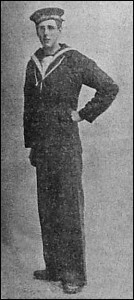Joining the minesweeper service was one of the choices offered to Conscientious Objectors by the tribunals. Men could also volunteer for this service without going before a tribunal. Far from being an easy, safe option however, there was great danger in this work and the men really did risk their lives.

The story starts in 1907 when Admiral Lord Charles Beresford, Commander-in-Chief of the Home Fleet, visited ports on the east coast of England where he saw the Grimsby trawlers and realised they were ideal for minesweeping duties. In a letter he wrote;
“Our fishing fleets, in war, will be rendered inactive and will, in consequence be available for war service. Fishermen, by virtue of their calling, are adept in the handling and towing of wires and trawls, more so than are naval ratings. Small naval vessels, if used in minesweeping, will be used at the expense of other urgent war requirements.”
His foresight led to the formation of the Royal Naval Reserve (Trawler Section) – the RNR (T), and within the first week of the war ninety-four trawlers had been allocated for minesweeping duties around what were considered “priority areas”, such as Cromarty, the Firth of Forth, the Tyne, the Humber, Harwich, Sheerness, Dover, Portsmouth, Portland and Plymouth.
The trawlers were all commanded by naval officers, some who came from the retired list, and these men were given training in minesweeping. To man these minesweepers, because most of the trained pre-war Royal Navy Reserve and Royal Navy Volunteer Reserve officers had been called up to serve in the Fleet, officers and civilians were taken from the Merchant Navy and given temporary commissions in both the RNR and RNVR.
It was into this service that pacifists and conscientious objectors of all sorts came – some volunteering before call-up, and some as a result of a Tribunal decision.
What was a First World War Sea Mine, and how did it work?
The most common sea mine in the First World War was a “contact mine”, usually a spherical container containing enough explosive material to severely damage or sink a ship. The top, outside of the mine carried several protruding metal knobs, known as “Hertz Horns”, after the German inventor from the 1870s.
Encased in each horn was a glass tube of sulphuric acid, which, when hit by a ship or other object, broke allowing the acid to drip onto a lead-acid battery. This produced an electric current that detonated the explosives in the main body of the mine.
Minesweeping
By 1914, Germany and Britain had built stocks of sea mine and various types of mine layer. Potentially, the sea mine was more of a threat to British vessels as few German ships dared to sail that close to British waters and British vessels increasingly travelled in convoy. The use of sea mines for defensive and offensive purposes rapidly developed from 1914 to 1918 and was repeated and further developed during the Second World War.
Laying mines was simple and could be undertaken by a variety of vessels, including submarines. The sea mines sat on a wheeled base that included a weight and a length of cable which attached the weight to the mine. As a minelayer steamed on a set course, the mines were pushed down a track and over the stern. As the mine sank, a hydrostatic valve armed the mine and allowed it to float free from the weight, but attached by the line.
The position and course of the minelayer was carefully plotted so that friendly vessels could avoid the minefield. As the cables ran out, mines in the field would float at different depths to present the maximum threat to surface vessels and submarines. A submarine might initially miss a mine and snag the cable, usually on the diving planes. As the submarine moved forward, the mine would be dragged down towards the vessel, detonating on contact with the hull. In 1914, mines were usually either spherical or egg-shaped. The detonators were normally mounted on the top of the mine, or towards the top. During the First World War, the sea mine was a relatively cheap and simple weapon that depended on a vessel striking the horns to detonate the charge.
Britain laid large defensive minefields around its coasts and in the North Sea. British convoys and independent vessels could then travel in clear lanes between the fields, reducing the directions and opportunities for attack by German vessels. The weakness of this tactic was that storms could cause mines to break free and end up in what should have been free lanes, accounting for the sinking of a number of British vessels. Similarly, the Germans could lay mines in the lanes and sink even more vessels. This meant that Britain needed effective minesweepers and even when sailing in clear lanes, a minesweeper would sail ahead of a convoy to make sure there were no enemy mines or rogue British mines in the lanes.
The standard method of minesweeping in the First World War was to stream a cable with a paravane at one end and the ship at the other. This allowed the sweep to run at a set depth and cut the cable of any mine in its path. The mine would then bob free and be destroyed by gunfire or recovered by a small boat and disarmed or exploded safely.
The final clear up in peacetime displayed one serious weakness of mine warfare. Maps of minefields were lost or inaccurate and during storms mines would break free from their moorings. Today North Sea coasts continue to see sea mines washed ashore, including those dating from the First World War. Some of these antiques mines are still dangerous explosive devices and all have to be treated as active.

